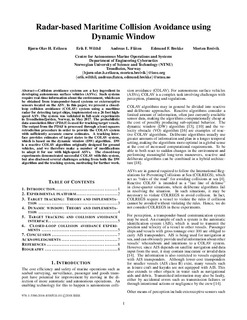| dc.contributor.author | Eriksen, Bjørn-Olav Holtung | |
| dc.contributor.author | Wilthil, Erik Falmår | |
| dc.contributor.author | Flåten, Andreas Lindahl | |
| dc.contributor.author | Brekke, Edmund Førland | |
| dc.contributor.author | Breivik, Morten | |
| dc.date.accessioned | 2019-03-28T14:29:24Z | |
| dc.date.available | 2019-03-28T14:29:24Z | |
| dc.date.created | 2018-06-04T12:53:03Z | |
| dc.date.issued | 2018 | |
| dc.identifier.citation | IEEE Aerospace Conference. Proceedings. 2018, 2018-March 1-9. | nb_NO |
| dc.identifier.issn | 1095-323X | |
| dc.identifier.uri | http://hdl.handle.net/11250/2592280 | |
| dc.description.abstract | Collision avoidance systems are a key ingredient in developing autonomous surface vehicles (ASVs). Such systems require real-time information about the environment, which can be obtained from transponder-based systems or exteroceptive sensors located on the ASV. In this paper, we present a closed-loop collision avoidance (COLAV) system using a maritime radar for detecting target ships, implemented on a 26 foot high-speed ASV. The system was validated in full-scale experiments in Trondheimsfjorden, Norway, in May 2017. The probabilistic data association filter (PDAF) is used for tracking target vessels. The output from the PDAF is processed through a least-squares retrodiction procedure in order to provide the COLAV system with sufficiently accurate course estimates. A tracking interface provides estimates of target states to the COLAV system, which is based on the dynamic window (DW) algorithm. DW is a reactive COLAV algorithm originally designed for ground vehicles, and we therefore make a number of modifications to adapt it for use with high-speed ASVs. The closed-loop experiments demonstrated successful COLAV with this system, but also disclosed several challenges arising from both the DW algorithm and the tracking system, motivating for further work. | nb_NO |
| dc.language.iso | eng | nb_NO |
| dc.publisher | Institute of Electrical and Electronics Engineers (IEEE) | nb_NO |
| dc.title | Radar-based Maritime Collision Avoidance using Dynamic Window | nb_NO |
| dc.type | Journal article | nb_NO |
| dc.type | Peer reviewed | nb_NO |
| dc.description.version | acceptedVersion | nb_NO |
| dc.source.pagenumber | 1-9 | nb_NO |
| dc.source.volume | 2018-March | nb_NO |
| dc.source.journal | IEEE Aerospace Conference. Proceedings | nb_NO |
| dc.identifier.doi | 10.1109/AERO.2018.8396666 | |
| dc.identifier.cristin | 1588762 | |
| dc.relation.project | Norges forskningsråd: 244116 | nb_NO |
| dc.relation.project | Norges forskningsråd: 223254 | nb_NO |
| dc.description.localcode | © 2018 IEEE. Personal use of this material is permitted. Permission from IEEE must be obtained for all other uses, in any current or future media, including reprinting/republishing this material for advertising or promotional purposes, creating new collective works, for resale or redistribution to servers or lists, or reuse of any copyrighted component of this work in other works. | nb_NO |
| cristin.unitcode | 194,63,25,0 | |
| cristin.unitname | Institutt for teknisk kybernetikk | |
| cristin.ispublished | true | |
| cristin.fulltext | postprint | |
| cristin.qualitycode | 1 | |
